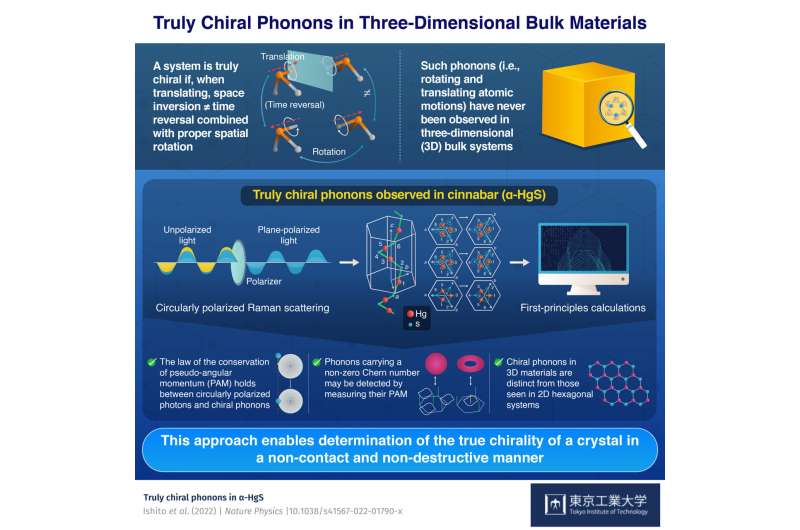Truly chiral phonons observed in three-dimensional materials for the first time

Chirality is the breaking of reflection and inversion symmetries. Simply put, it is when an object's mirror images cannot be superimposed over each other. A common example are your two hands—while mirror images of each other, they can never overlap. Chirality appears at all levels in nature and is ubiquitous.
In addition to static chirality, chirality can also occur due to dynamic motion including rotation. With this in mind, we can distinguish true and false chirality. A system is truly chiral if—when translating—space inversion does not equate to time reversal combined with a proper spatial rotation.
Phonons are quanta (or small packets) of energy associated with the vibration of atoms in a crystal lattice. Recently, phonons with chiral properties have been theorized and experimentally discovered in two-dimensional (2D) materials such as tungsten diselenide. The discovered chiral phonons are rotating—yet not propagating—atomic motions. But, truly chiral phonons would be atomic motions that are both rotating and propagating, and these have never been observed in three-dimensional (3D) bulk systems.
Now, a team of researchers led by scientists from Tokyo Institute of Technology (Tokyo Tech) has identified truly chiral phonons, both theoretically and experimentally. Their work is published in Nature Physics. The team, led by Professor Takuya Satoh of the Department of Physics at Tokyo Tech, observed the chiral phonons in cinnabar (α-HgS). This was achieved using a combination of first-principles calculations and an experimental technique called circularly polarized Raman scattering.
"Chiral structures can be probed using chiral techniques. So, using circularly polarized light, which has its own handedness (i.e., right-handed or left-handedness), is critical. Dynamic chiral structures can be mapped using pseudo-angular momentum (PAM). Pseudo-momentum and PAM originate from the phase factors acquired by discrete translation and rotation symmetry operations, respectively," explains Professor Satoh.
The researchers' novel experimental approach also allowed them to probe the fundamental traits of PAM. They found that the law of the conservation of PAM—one of the key laws of physics—holds between circularly polarized photons and chiral phonons.
"Our work also provides an optical method to identify the handedness of chiral materials using PAM. Namely, we can determine the handedness of materials with better resolution than X-ray diffraction (XRD) can achieve. Moreover, XRD requires a large-enough crystal, is invasive, and can be destructive. Circularly polarized Raman scattering, on the other hand, allowed us to determine the chirality of structures XRD could not, in a non-contact and non-destructive manner," concludes Professor Satoh.
This study is the first to identify truly chiral phonons in 3D materials, which are clearly distinct from those seen previously in 2D hexagonal systems. The knowledge gained here could drive new research into developing ways for transferring the PAM from photons to electron spins via propagating chiral phonons in future devices. Furthermore, this approach enables the determination of the true chirality of a crystal in an improved manner, providing a new critical tool for experimentalists' and researchers.
More information: Kyosuke Ishito et al, Truly chiral phonons in α-HgS, Nature Physics (2022). DOI: 10.1038/s41567-022-01790-x
Journal information: Nature Physics
Provided by Tokyo Institute of Technology





















